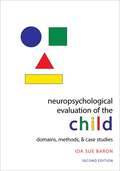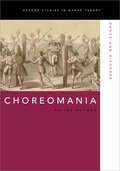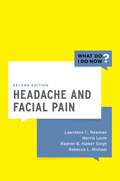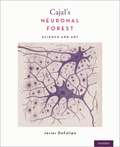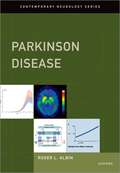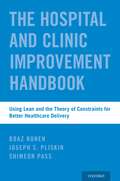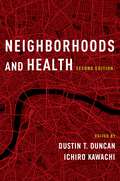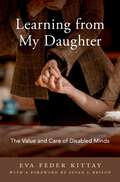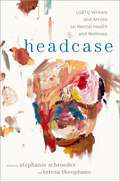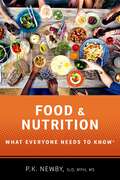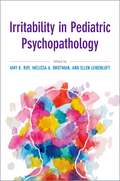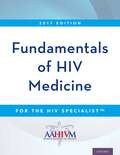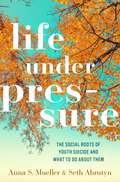- Table View
- List View
Neuropsychological Evaluation of the Child: Domains, Methods, & Case Studies
by Ida Sue BaronNeuropsychological Evaluation of the Child: Domains, Methods, and Case Studies, Second Edition, is an updated and expanded desk reference that retains the first edition's organizational structure, strong practical focus, and lifespan developmental perspective. It is a unique compilation of published and unpublished pediatric neuropsychological test normative data that contains extensive discussion of assessment methods and case formulation. Added for the first time are instructive clinical case vignettes that explicate brain-behavior relationships in youth, from preschool-age through adolescence. These cases illustrate immediate and late effects that result from common and rare medical diseases and psychological disorders, and highlight key issues that arise when examining a child's maturational trajectory and brain-behavioral relationships using convergence profile analysis. Part I, Child Neuropsychology: Current Status, contains four introductory chapters regarding definitions, education and training, and professional roles; reasons for referral; typical and atypical brain development; and clinical practice considerations. In Part II, Clinical Issues, discussion covers the procedural steps of neuropsychological assessment, behavioral assessment techniques, observational data, and oral and written communication of results. These chapters are followed in Part III, Domains and Tests, by extended coverage of topics and tests related to the major neuropsychological domains: intelligence, executive function, attention and processing speed, language, motor and sensory-perceptual function, visuoperceptual, visuospatial and visuoconstructional function, and learning and memory. A final chapter addresses deception in childhood, reasons why a child might reduce effort and invalidate assessment, and the use of performance validity tests, symptom validity tests, and embedded validity indicators to assess noncredible effort. Each of the 16 chapters includes definitions, theoretical concepts, models, and assessment techniques that are essential knowledge for clinical and research pediatric neuropsychologists.
Neuropsychological Evaluation of the Child: Domains, Methods, & Case Studies
by Ida Sue BaronNeuropsychological Evaluation of the Child: Domains, Methods, and Case Studies, Second Edition, is an updated and expanded desk reference that retains the first edition's organizational structure, strong practical focus, and lifespan developmental perspective. It is a unique compilation of published and unpublished pediatric neuropsychological test normative data that contains extensive discussion of assessment methods and case formulation. Added for the first time are instructive clinical case vignettes that explicate brain-behavior relationships in youth, from preschool-age through adolescence. These cases illustrate immediate and late effects that result from common and rare medical diseases and psychological disorders, and highlight key issues that arise when examining a child's maturational trajectory and brain-behavioral relationships using convergence profile analysis. Part I, Child Neuropsychology: Current Status, contains four introductory chapters regarding definitions, education and training, and professional roles; reasons for referral; typical and atypical brain development; and clinical practice considerations. In Part II, Clinical Issues, discussion covers the procedural steps of neuropsychological assessment, behavioral assessment techniques, observational data, and oral and written communication of results. These chapters are followed in Part III, Domains and Tests, by extended coverage of topics and tests related to the major neuropsychological domains: intelligence, executive function, attention and processing speed, language, motor and sensory-perceptual function, visuoperceptual, visuospatial and visuoconstructional function, and learning and memory. A final chapter addresses deception in childhood, reasons why a child might reduce effort and invalidate assessment, and the use of performance validity tests, symptom validity tests, and embedded validity indicators to assess noncredible effort. Each of the 16 chapters includes definitions, theoretical concepts, models, and assessment techniques that are essential knowledge for clinical and research pediatric neuropsychologists.
Choreomania: Dance and Disorder (Oxford Studies in Dance Theory)
by Kélina GotmanWhen political protest is read as epidemic madness, religious ecstasy as nervous disease, and angular dance moves as dark and uncouth, the 'disorder' being described is choreomania. At once a catchall term to denote spontaneous gestures and the unruly movements of crowds, 'choreomania' emerged in the nineteenth century at a time of heightened class conflict, nationalist policy, and colonial rule. In this book, author Kélina Gotman examines these choreographies of unrest, rethinking the modern formation of the choreomania concept as it moved across scientific and social scientific disciplines. Reading archives describing dramatic misformations-of bodies and body politics-she shows how prejudices against expressivity unravel, in turn revealing widespread anxieties about demonstrative agitation. This history of the fitful body complements stories of nineteenth-century discipline and regimentation. As she notes, constraints on movement imply constraints on political power and agency. In each chapter, Gotman confronts the many ways choreomania works as an extension of discourses shaping colonialist orientalism, which alternately depict riotous bodies as dangerously infected others, and as curious bacchanalian remains. Through her research, Gotman also shows how beneath the radar of this colonial discourse, men and women gathered together to repossess on their terms the gestures of social revolt.
CHOREOMANIA OSDT C: Dance and Disorder (Oxford Studies in Dance Theory)
by Kélina GotmanWhen political protest is read as epidemic madness, religious ecstasy as nervous disease, and angular dance moves as dark and uncouth, the 'disorder' being described is choreomania. At once a catchall term to denote spontaneous gestures and the unruly movements of crowds, 'choreomania' emerged in the nineteenth century at a time of heightened class conflict, nationalist policy, and colonial rule. In this book, author Kélina Gotman examines these choreographies of unrest, rethinking the modern formation of the choreomania concept as it moved across scientific and social scientific disciplines. Reading archives describing dramatic misformations-of bodies and body politics-she shows how prejudices against expressivity unravel, in turn revealing widespread anxieties about demonstrative agitation. This history of the fitful body complements stories of nineteenth-century discipline and regimentation. As she notes, constraints on movement imply constraints on political power and agency. In each chapter, Gotman confronts the many ways choreomania works as an extension of discourses shaping colonialist orientalism, which alternately depict riotous bodies as dangerously infected others, and as curious bacchanalian remains. Through her research, Gotman also shows how beneath the radar of this colonial discourse, men and women gathered together to repossess on their terms the gestures of social revolt.
Headache and Facial Pain (What Do I Do Now)
by Lawrence Newman Morris Levin Rashmi Halker Rebecca MichaelIn this new edition of Headache and Facial Pain in the "What Do I Do Now?" series, the authors have added cases dealing with issues that were not included in the first edition, eliminated several chapters that were no longer topical or in which recommendations were not current, and updated the rest. The book continues to simulate the "curbside consultation" in our selection of 37 cases about headache and facial pain. Each "case" poses an important question to be discussed and each are addressed, much as a consultant would do over the phone or in the hallway, using current evidence and experienced-based information. We have divided this volume into four sections that cover the typical ground for head/face pain consultation: Section 1, Diagnostic Questions; Section 2, Treatment Questions; Section 3, Questions Related to Special Populations; and Section 4 Prognostic, Social, and Legal Issues. Diagnostic reasoning is presented along the lines of the International Classification of Headache Disorders, third edition (ICHD-III). Additionally, recommendations for adding or modifying new treatment modalities (pharmacologic and devices) that have been approved since publication of the first edition have been incorporated based on updates from the AHS consensus statement. A list of key clinical points again appears at the end of each case discussion, followed by a list of suggested articles or chapters for those interested in doing further reading on the subject.
Headache and Facial Pain (What Do I Do Now)
by Morris Levin Rebecca Michael Lawrence Newman Rashmi HalkerIn this new edition of Headache and Facial Pain in the "What Do I Do Now?" series, the authors have added cases dealing with issues that were not included in the first edition, eliminated several chapters that were no longer topical or in which recommendations were not current, and updated the rest. The book continues to simulate the "curbside consultation" in our selection of 37 cases about headache and facial pain. Each "case" poses an important question to be discussed and each are addressed, much as a consultant would do over the phone or in the hallway, using current evidence and experienced-based information. We have divided this volume into four sections that cover the typical ground for head/face pain consultation: Section 1, Diagnostic Questions; Section 2, Treatment Questions; Section 3, Questions Related to Special Populations; and Section 4 Prognostic, Social, and Legal Issues. Diagnostic reasoning is presented along the lines of the International Classification of Headache Disorders, third edition (ICHD-III). Additionally, recommendations for adding or modifying new treatment modalities (pharmacologic and devices) that have been approved since publication of the first edition have been incorporated based on updates from the AHS consensus statement. A list of key clinical points again appears at the end of each case discussion, followed by a list of suggested articles or chapters for those interested in doing further reading on the subject.
Cajal's Neuronal Forest: Science and Art
by Javier DeFelipeCajal's Neuronal Forest: Science and Art continues the tradition set forth by its sister volume Cajal's Butterflies of the Soul (OUP, 2009). This new collection contains hundreds of beautiful rarely-seen-before figures produced throughout the nineteenth century and the beginning of the twentieth century by famed father-of-modern-neuroscience Santiago Ramón y Cajal (1852-1934) and his contemporaries. Cajal was captivated by the beautiful shapes of the cells of the nervous system. He and his fellow scientists saw neurons as trees and glial cells as bushes. Given their high density and arrangement, neurons and glial resembled a thick forest, a seemingly impenetrable terrain of interacting cells mediating cognition and behavior. In unraveling the mysteries of the brain, these researchers encountered an almost infinite number of cellular forms with an extraordinary beauty, which they could not help but put pen to paper, allowing them to discover a new artistic world- the neuronal forest- that gave free rein not only to their imagination, but to a new way of viewing the brain as well. This book has been divided into two parts. The first focuses on the scientific atmosphere in Cajal's times, on the history of the neuron, and the anatomical challenge posed in studying neuronal connections. It also delves into the artistic skills of Cajal and other important pioneers in neuroscience and how the neuronal forests have served as an unlimited source of artistic inspiration. The second consists of 275 original drawings by Cajal. All were published over the course of his scientific career and cover virtually all of his research fields of interest, including the spinal cord, the optic lobe and retina, cerebral cortex, and many other regions of the brain. Cajal's Neuronal Forest: Science and Art is a testament to the natural beauty found in science. Despite the common misconception that the drawings of Cajal and other scientists of the time are pieces of art, these drawings are in fact copies of histological preparations and contributed greatly to the discoveries made in the field of neuroscience. This book is a gem in any library, whether serving as a medical history or a gallery of stunning sketches.
Cajal's Neuronal Forest: Science and Art
by Javier DeFelipeCajal's Neuronal Forest: Science and Art continues the tradition set forth by its sister volume Cajal's Butterflies of the Soul (OUP, 2009). This new collection contains hundreds of beautiful rarely-seen-before figures produced throughout the nineteenth century and the beginning of the twentieth century by famed father-of-modern-neuroscience Santiago Ramón y Cajal (1852-1934) and his contemporaries. Cajal was captivated by the beautiful shapes of the cells of the nervous system. He and his fellow scientists saw neurons as trees and glial cells as bushes. Given their high density and arrangement, neurons and glial resembled a thick forest, a seemingly impenetrable terrain of interacting cells mediating cognition and behavior. In unraveling the mysteries of the brain, these researchers encountered an almost infinite number of cellular forms with an extraordinary beauty, which they could not help but put pen to paper, allowing them to discover a new artistic world- the neuronal forest- that gave free rein not only to their imagination, but to a new way of viewing the brain as well. This book has been divided into two parts. The first focuses on the scientific atmosphere in Cajal's times, on the history of the neuron, and the anatomical challenge posed in studying neuronal connections. It also delves into the artistic skills of Cajal and other important pioneers in neuroscience and how the neuronal forests have served as an unlimited source of artistic inspiration. The second consists of 275 original drawings by Cajal. All were published over the course of his scientific career and cover virtually all of his research fields of interest, including the spinal cord, the optic lobe and retina, cerebral cortex, and many other regions of the brain. Cajal's Neuronal Forest: Science and Art is a testament to the natural beauty found in science. Despite the common misconception that the drawings of Cajal and other scientists of the time are pieces of art, these drawings are in fact copies of histological preparations and contributed greatly to the discoveries made in the field of neuroscience. This book is a gem in any library, whether serving as a medical history or a gallery of stunning sketches.
Parkinson Disease (CONTEMPORARY NEUROLOGY SERIES)
by Roger L. AlbinParkinson Disease is a comprehensive introduction to the biology and clinical features of Parkinson disease (PD). This book is aimed at clinicians in training, general neurologists seeking a useful guide to PD, and scientists seeking an overview of clinical aspects of PD. Topics covered include nosology of PD, PD epidemiology, pathology and pathophysiology of PD, and theories of PD pathogenesis. Clinical features, including the many non-motor features, natural history of disease progression, clinical pharmacology, and management of PD receive coverage. Important themes are heterogeneity of PD, the multi-focal nature of PD pathology, the diversity of clinical features, dopaminergic signaling and the impacts of dopaminergic deficiency, the importance of non-motor features, limitations of existing treatment modalities, and the necessity of approaching PD as a multi-system disorder. The description and discussion of the many aspects of Parkinson disease (PD) is dogged by the fact that PD is an ambiguous concept. This book intends to be a useful overview, bridging the gap between general textbooks and specific topical reviews.
Parkinson Disease (CONTEMPORARY NEUROLOGY SERIES)
by Roger L. AlbinParkinson Disease is a comprehensive introduction to the biology and clinical features of Parkinson disease (PD). This book is aimed at clinicians in training, general neurologists seeking a useful guide to PD, and scientists seeking an overview of clinical aspects of PD. Topics covered include nosology of PD, PD epidemiology, pathology and pathophysiology of PD, and theories of PD pathogenesis. Clinical features, including the many non-motor features, natural history of disease progression, clinical pharmacology, and management of PD receive coverage. Important themes are heterogeneity of PD, the multi-focal nature of PD pathology, the diversity of clinical features, dopaminergic signaling and the impacts of dopaminergic deficiency, the importance of non-motor features, limitations of existing treatment modalities, and the necessity of approaching PD as a multi-system disorder. The description and discussion of the many aspects of Parkinson disease (PD) is dogged by the fact that PD is an ambiguous concept. This book intends to be a useful overview, bridging the gap between general textbooks and specific topical reviews.
The Hospital and Clinic Improvement Handbook: Using Lean and the Theory of Constraints for Better Healthcare Delivery
by Boaz Ronen Joseph S. Pliskin Shimeon PassThe essential healthcare guide to doing more with existing resources The healthcare industry faces foundational challenges to how it sustains itself. As the gap between cost and revenue continues to widen, and as cost-effectiveness remains an elusive imperative, the question persists: how can healthcare organizations do more with the same resources? The Hospital and Clinic Improvement Handbook is a practical guide to how operations management -- in particular Lean and the Theory of Constraints (TOC) -- can rapidly advance value and performance in any healthcare organization. Utilizing a systems approach that will be relevant for healthcare managers and executives, it unpacks and demystifies concepts such as performance measures, operations, quality, cost accounting, pricing, and value enhancement, all as they relate to eliminating waste and non-value-adding activities. Enriched with dozens of examples and building on the authors' experience teaching and refining these concepts for healthcare, this text is an essential guide for executives and managers across the industry.
The Hospital and Clinic Improvement Handbook: Using Lean and the Theory of Constraints for Better Healthcare Delivery
by Joseph S. Pliskin Boaz Ronen Shimeon PassThe essential healthcare guide to doing more with existing resources The healthcare industry faces foundational challenges to how it sustains itself. As the gap between cost and revenue continues to widen, and as cost-effectiveness remains an elusive imperative, the question persists: how can healthcare organizations do more with the same resources? The Hospital and Clinic Improvement Handbook is a practical guide to how operations management -- in particular Lean and the Theory of Constraints (TOC) -- can rapidly advance value and performance in any healthcare organization. Utilizing a systems approach that will be relevant for healthcare managers and executives, it unpacks and demystifies concepts such as performance measures, operations, quality, cost accounting, pricing, and value enhancement, all as they relate to eliminating waste and non-value-adding activities. Enriched with dozens of examples and building on the authors' experience teaching and refining these concepts for healthcare, this text is an essential guide for executives and managers across the industry.
Neighborhoods and Health
THE GROUNDBREAKING, FORMATIVE WORK IN SPATIAL EPIDEMIOLOGY -- NOW UPDATED FOR A NEW GENERATION OF RESEARCH AND PRACTICE IN PUBLIC HEALTH In 2003, Neighborhoods and Health codified the idea that a neighborhood's social and physical makeup can influence the health of people who live in it. More than a decade later, with the relationship between place and health firmly entrenched at the center of how we understand public health (and as its own scientific discipline, spatial epidemiology), this second edition of the landmark text offers another giant leap forward for the field. Offering both a synthesis of the essential research and a practical overview of the methods used to garner it, the second edition of Neighborhoods and Health is the essential guide to understanding this core component of contemporary population health -- both the journey to date and what's next.
NEIGHBORHOODS & HEALTH 2E C
by Dustin T. Duncan and Ichiro KawachiTHE GROUNDBREAKING, FORMATIVE WORK IN SPATIAL EPIDEMIOLOGY -- NOW UPDATED FOR A NEW GENERATION OF RESEARCH AND PRACTICE IN PUBLIC HEALTH In 2003, Neighborhoods and Health codified the idea that a neighborhood's social and physical makeup can influence the health of people who live in it. More than a decade later, with the relationship between place and health firmly entrenched at the center of how we understand public health (and as its own scientific discipline, spatial epidemiology), this second edition of the landmark text offers another giant leap forward for the field. Offering both a synthesis of the essential research and a practical overview of the methods used to garner it, the second edition of Neighborhoods and Health is the essential guide to understanding this core component of contemporary population health -- both the journey to date and what's next.
Learning from My Daughter: The Value and Care of Disabled Minds
by Eva Feder KittayDoes life have meaning? What is flourishing? How do we attain the good life? Philosophers, and many others of us, have explored these questions for centuries. As Eva Feder Kittay points out, however, there is a flaw in the essential premise of these questions: they seem oblivious to the very nature of the ways in which humans live, omitting a world of co-dependency, and of the fact that we live in and through our bodies, whether they are fully abled or disabled. Our dependent, vulnerable, messy, changeable, and embodied experience colors everything about our lives both on the surface and when it comes to deeper concepts, but we tend to leave aside the body for the mind when it comes to philosophical matters. Disability offers a powerful challenge to long-held philosophical views about the nature of the good life, what provides meaning in our lives, and the centrality of reason, as well as questions of justice, dignity, and personhood. These concepts need not be distant and idealized; the answers are right before us, in the way humans interact with one another, care for one another, and need one another--whether they possess full mental capacities or have cognitive limitations. We need to revise our concepts of things like dignity and personhood in light of this important correction, Kittay argues. This is the first of two books in which Kittay will grapple with just how we need to revisit core philosophical ideas in light of disabled people's experience and way of being in the world. Kittay, an award-winning philosopher who is also the mother to a multiply-disabled daughter, interweaves the personal voice with the philosophical as a critical method of philosophical investigation. Here, she addresses why cognitive disability can reorient us to what truly matters, and questions the centrality of normalcy as part of a good life. With profound sensitivity and insight, Kittay examines other difficult topics: How can we look at the ethical questions regarding prenatal testing in light of a new appreciation of the personhood of disabled people? What do new possibilities in genetic testing imply for understanding disability, the family, and bioethics? How can we reconsider the importance of care, and how does it work best? In the process of pursuing these questions, Kittay articulates an ethic of care, which is the ethical theory most useful for claiming full rights for disabled people and providing the opportunities for everyone to live joyful and fulfilling lives. She applies the lessons of care to the controversial alteration of severely cognitively disabled children known as the Ashley Treatment, whereby a child's growth is halted with extensive estrogen treatment and related bodily interventions are justified. This book both imparts lessons that advocate on behalf of those with significant disabilities, and constructs a moral theory grounded on our ability to give, receive, and share care and love. Above all, it aims to adjust social attitudes and misconceptions about life with disability.
Learning from My Daughter: The Value and Care of Disabled Minds
by Eva Feder KittayDoes life have meaning? What is flourishing? How do we attain the good life? Philosophers, and many others of us, have explored these questions for centuries. As Eva Feder Kittay points out, however, there is a flaw in the essential premise of these questions: they seem oblivious to the very nature of the ways in which humans live, omitting a world of co-dependency, and of the fact that we live in and through our bodies, whether they are fully abled or disabled. Our dependent, vulnerable, messy, changeable, and embodied experience colors everything about our lives both on the surface and when it comes to deeper concepts, but we tend to leave aside the body for the mind when it comes to philosophical matters. Disability offers a powerful challenge to long-held philosophical views about the nature of the good life, what provides meaning in our lives, and the centrality of reason, as well as questions of justice, dignity, and personhood. These concepts need not be distant and idealized; the answers are right before us, in the way humans interact with one another, care for one another, and need one another--whether they possess full mental capacities or have cognitive limitations. We need to revise our concepts of things like dignity and personhood in light of this important correction, Kittay argues. This is the first of two books in which Kittay will grapple with just how we need to revisit core philosophical ideas in light of disabled people's experience and way of being in the world. Kittay, an award-winning philosopher who is also the mother to a multiply-disabled daughter, interweaves the personal voice with the philosophical as a critical method of philosophical investigation. Here, she addresses why cognitive disability can reorient us to what truly matters, and questions the centrality of normalcy as part of a good life. With profound sensitivity and insight, Kittay examines other difficult topics: How can we look at the ethical questions regarding prenatal testing in light of a new appreciation of the personhood of disabled people? What do new possibilities in genetic testing imply for understanding disability, the family, and bioethics? How can we reconsider the importance of care, and how does it work best? In the process of pursuing these questions, Kittay articulates an ethic of care, which is the ethical theory most useful for claiming full rights for disabled people and providing the opportunities for everyone to live joyful and fulfilling lives. She applies the lessons of care to the controversial alteration of severely cognitively disabled children known as the Ashley Treatment, whereby a child's growth is halted with extensive estrogen treatment and related bodily interventions are justified. This book both imparts lessons that advocate on behalf of those with significant disabilities, and constructs a moral theory grounded on our ability to give, receive, and share care and love. Above all, it aims to adjust social attitudes and misconceptions about life with disability.
Headcase: LGBTQ Writers & Artists on Mental Health and Wellness
Headcase is a groundbreaking collection of personal reflections and artistic representations illustrating the intersection of mental wellness, mental illness, and LGBTQ identity, as well as the lasting impact of historical views equating queer and trans identity with mental illness. The featured pieces offer personal views from both providers and clients, often one and the same, about their experiences. In the anthology, readers will access the inner thoughts of contributors who collectively document the difficulty of navigating flawed healthcare systems that limit affordable access to genuinely affirming, effective services. Traversing boundaries of race and ethnic identity, age, gender identity, and socioeconomic status, Headcase appeals to LGBTQ communities and, specifically, LGBTQ mental health consumers and their friends, families, and comrades.
Headcase: LGBTQ Writers & Artists on Mental Health and Wellness
by Stephanie Schroeder and Teresa TheophanoHeadcase is a groundbreaking collection of personal reflections and artistic representations illustrating the intersection of mental wellness, mental illness, and LGBTQ identity, as well as the lasting impact of historical views equating queer and trans identity with mental illness. The featured pieces offer personal views from both providers and clients, often one and the same, about their experiences. In the anthology, readers will access the inner thoughts of contributors who collectively document the difficulty of navigating flawed healthcare systems that limit affordable access to genuinely affirming, effective services. Traversing boundaries of race and ethnic identity, age, gender identity, and socioeconomic status, Headcase appeals to LGBTQ communities and, specifically, LGBTQ mental health consumers and their friends, families, and comrades.
Food and Nutrition: What Everyone Needs to Know® (What Everyone Needs To Know®)
by P.K. NewbyFrom gluten-free to all-Paleo, GMOs to grass-fed beef, our newsfeeds abound with nutrition advice. Whether sensational headlines from the latest study or anecdotes from celebrities and food bloggers, we're bombarded with "superfoods" and "best ever" diets promising to help us lose weight, fight disease, and live longer. At the same time, we live in an over-crowded food environment that makes it easy to eat, all the time. The result is an epidemic of chronic disease amidst a culture of nutrition confusion-and copious food choices that challenge everyday eaters just trying to get a healthy meal on the table. But the exhilarating truth is that scientists know an astounding amount about the power of food. A staggering 80% of chronic diseases are preventable through modifiable lifestyle changes, and diet is the single largest contributing factor. And we also know the secrets to eating sustainably to protect our planet. In Food & Nutrition, Harvard- and Columbia-trained nutrition scientist Dr. P.K. Newby examines 134 stand-alone questions addressing "need to know" topics, including how what we eat affects our health and environment, from farm to fork, and why, when it comes to diet, the whole is greater than the sum of its parts-and one size doesn't fit all. At the same time, Newby debunks popular myths and food folklore, encouraging readers to "learn, unlearn, and relearn" the fundamentals of nutrition at the heart of a health-giving diet. Her passion for all things food shines through it all, as does her love of the power of science, technology, and engineering to help create healthier diets for ourselves, and a more sustainable future for the planet we share.
FOOD & NUTRITION WENK C: What Everyone Needs to Know® (What Everyone Needs To Know®)
by P.K. NewbyFrom gluten-free to all-Paleo, GMOs to grass-fed beef, our newsfeeds abound with nutrition advice. Whether sensational headlines from the latest study or anecdotes from celebrities and food bloggers, we're bombarded with "superfoods" and "best ever" diets promising to help us lose weight, fight disease, and live longer. At the same time, we live in an over-crowded food environment that makes it easy to eat, all the time. The result is an epidemic of chronic disease amidst a culture of nutrition confusion-and copious food choices that challenge everyday eaters just trying to get a healthy meal on the table. But the exhilarating truth is that scientists know an astounding amount about the power of food. A staggering 80% of chronic diseases are preventable through modifiable lifestyle changes, and diet is the single largest contributing factor. And we also know the secrets to eating sustainably to protect our planet. In Food & Nutrition, Harvard- and Columbia-trained nutrition scientist Dr. P.K. Newby examines 134 stand-alone questions addressing "need to know" topics, including how what we eat affects our health and environment, from farm to fork, and why, when it comes to diet, the whole is greater than the sum of its parts-and one size doesn't fit all. At the same time, Newby debunks popular myths and food folklore, encouraging readers to "learn, unlearn, and relearn" the fundamentals of nutrition at the heart of a health-giving diet. Her passion for all things food shines through it all, as does her love of the power of science, technology, and engineering to help create healthier diets for ourselves, and a more sustainable future for the planet we share.
Irritability in Pediatric Psychopathology
Pediatric irritability, defined as increased proneness to anger relative to peers, is among the most common reasons for mental health referrals. The past fifteen years have witnessed a dramatic rise in the empirical study of pediatric irritability with the goal of developing more effective methods of assessing and treating these impaired youth. Irritability in Pediatric Psychopathology offers a comprehensive overview of this work, approaching the topic from multiple perspectives and disciplines including child psychiatry, clinical psychology, developmental psychology, and neuroscience. Offering five sections composed of chapters written by international experts, the book begins be defining pediatric irritability, reviewing its prevalence, current assessment methods, and novel behavioral and psychophysiological indicators. The second section reviews the literature on the development of pediatric irritability from preschool age through adolescence and young adulthood. The third section summarizes the current evidence for genetic and neurobiological factors contributing to pediatric irritability, while the fourth reviews its presentation transdiagnostically across mood and anxiety disorders, disruptive behavior disorders, and autism. Finally, the book concludes with a presentation of evidence-based psychological and pharmacological interventions. Irritability in Pediatric Psychopathology is an essential resource for researchers, clinicians, and trainees working with children and adolescents.
Irritability in Pediatric Psychopathology
by Amy Krain Roy, Melissa A. Brotman and Ellen LeibenluftPediatric irritability, defined as increased proneness to anger relative to peers, is among the most common reasons for mental health referrals. The past fifteen years have witnessed a dramatic rise in the empirical study of pediatric irritability with the goal of developing more effective methods of assessing and treating these impaired youth. Irritability in Pediatric Psychopathology offers a comprehensive overview of this work, approaching the topic from multiple perspectives and disciplines including child psychiatry, clinical psychology, developmental psychology, and neuroscience. Offering five sections composed of chapters written by international experts, the book begins be defining pediatric irritability, reviewing its prevalence, current assessment methods, and novel behavioral and psychophysiological indicators. The second section reviews the literature on the development of pediatric irritability from preschool age through adolescence and young adulthood. The third section summarizes the current evidence for genetic and neurobiological factors contributing to pediatric irritability, while the fourth reviews its presentation transdiagnostically across mood and anxiety disorders, disruptive behavior disorders, and autism. Finally, the book concludes with a presentation of evidence-based psychological and pharmacological interventions. Irritability in Pediatric Psychopathology is an essential resource for researchers, clinicians, and trainees working with children and adolescents.
Fundamentals of HIV Medicine 2017
by W. David Hardy American Academy of HIV MedicineCompletely updated for 2017, Fundamentals of HIV Medicine is a comprehensive clinical care publication for the treatment of HIV/AIDS. Published by the American Academy of HIV Medicine, the book offers physicians, pharmacists, nurse practitioners, and other care providers the most up-to-date overview of the latest HIV treatments and guidelines. Embodying the AAHIVM's commitment to promoting uniform excellence in care of seropositive patients, Fundamentals of HIV Medicine 2017 empowers health professionals to deliver standardized, life-sustaining treatment to the patients who need it most. It will serve as an essential clinical reference and provide valuable career enrichment to users across the spectrum of HIV care, treatment, and prevention.
Fundamentals of HIV Medicine 2017
by W. David Hardy American Academy of HIV MedicineCompletely updated for 2017, Fundamentals of HIV Medicine is a comprehensive clinical care publication for the treatment of HIV/AIDS. Published by the American Academy of HIV Medicine, the book offers physicians, pharmacists, nurse practitioners, and other care providers the most up-to-date overview of the latest HIV treatments and guidelines. Embodying the AAHIVM's commitment to promoting uniform excellence in care of seropositive patients, Fundamentals of HIV Medicine 2017 empowers health professionals to deliver standardized, life-sustaining treatment to the patients who need it most. It will serve as an essential clinical reference and provide valuable career enrichment to users across the spectrum of HIV care, treatment, and prevention.
Life under Pressure: The Social Roots of Youth Suicide and What to Do About Them
by Anna S. Mueller Seth AbrutynA rare study that transforms our understanding of why youth die by suicide, why youth suicide clusters happen, and how to stop them Youth suicide clusters have deeply unsettled communities in recent years. While clusters have been widely documented in the media, too little is known about why youth die by suicide, why youth suicide clusters happen, and how to stop them both. In Life under Pressure, Anna S. Mueller and Seth Abrutyn investigate the social roots of youth suicide and why certain places weather disproportionate incidents of adolescent suicides and suicide clusters. Through close examination of kids' lives in a community repeatedly rocked by youth suicide clusters, Mueller and Abrutyn reveal how the social worlds that youth inhabit and the various messages they learn in those spaces--about who they are supposed to be, mental illness, and help-seeking--shape their feelings about themselves and in turn their risk of suicide. With great empathy, Mueller and Abrutyn also identify the moments when adults unintentionally fail kids by not talking to them about suicide, teaching them how to seek help, or helping them grieve. Through stories of survival, resilience, and even rebellion, Mueller and Abrutyn show how social environments can cause suicide and how they can be changed to help kids discover a life worth living. By revealing what it is like to live and die in one community, Life under Pressure offers tangible solutions to one of the twenty-first century's most tragic public health problems.
